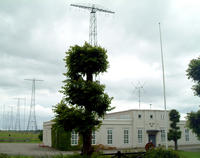You are in: Europe -> Sweden -> Varberg Radio Station, and traditional search or Image Gallery will yield results of this site only
Varberg Radio Station
| Site number: | 1134 |
|
| Type of site: | Cultural | |
| Date: | 1922-24 | |
| Date of Inscription: | 2004 | |
| Location: | Europe, Sweden, County of Halland | |
Up to 75 images are shown here. Click on each for more details or on Image Gallery for more images.
Six official UN languages:
Arabic,
Chinese,
English,
French,
Russian,
Spanish
Other languages: Dutch, German, Interlingua, Italian, Japanese, Norwegian-bokmål, Norwegian-nynorsk, Swedish
Other languages: Dutch, German, Interlingua, Italian, Japanese, Norwegian-bokmål, Norwegian-nynorsk, Swedish
| Description: | Standing at Grimeton in southern Sweden, the Varberg Radio Station, built in 1922-24, is as a remarkably well-preserved testament to early wireless transatlantic communication. It proudly contains transmitter equipment, consisting of six 127-m high steel towers that make up the aerial system. Despite the fact that it is no longer in regular use, the equipment has been upheld in working condition. The earliest Alexanderson transmitter, accompanied by the towers with their antennae, short-wave transmitters with their antennae, and a residential area with staff housing - all reside in this 109.9-ha site. Carl Åkerblad, the architect, designed the central buildings in the neoclassical style, whilst Henrik Kreüger, the structural engineer, was in charge of the antenna towers; during the time that they were built they reached to be the tallest structures in Sweden. The site exceptionally exemplifies the development of telecommunications and today it is the single surviving example of a foremost transmitting station founded on pre-electronic technology. --WHMNet paraphrase from the description at WHC Site, where additional information is available. | |
| The Grimeton VLF transmitter is a VLF transmission facility near Grimeton close to Varberg in Sweden. It was built in 1923 and has the only workable machine transmitter in the world. For its radiating element it uses a wire aerial hung on six 127-metre high freestanding steel towers looking like gigantic pylons. These towers are grounded. The VLF transmitter Grimeton was used until the fifties for transatlantic radio telegraphy to Radio Central in Long Island, New York, USA. After the fifties it was used until 1996 for transmitting orders to submarines. In 1968 therefore a second transmitter was installed. This transmitter uses transistor and tube technology unlike the machine transmitter, which works on 17.2 kHz, designed for frequencies around 40 kHz, but using the same aerial. In 1996 the machine transmitter became obsolete and went out of service. Because it is in good condition it was declared a national monument. On special occasions such as Alexanderson Day it is used for transmitting Morse messages on 17.2 kHz. The machine transmitter can be visited in the summertime. It is a great attraction especially on Alexanderson Day. The transmitter from the 1960s is still used by the Swedish Navy. Since it uses the same aerial as the machine transmitter a simultaneous operation of both transmitters, which would require expensive frequency filters, is not possible. So these special transmissions are very rare. The Grimeton VLF transmitter is not only used for VLF transmission. It is also used for shortwave transmissions and for FM and TV broadcasting. Therefore a 260 metre high guyed steel framework mast was built in 1966 next to the building containing the transmitter for 40 kHz. On July 2, 2004 the Grimeton VLF transmitter was declared a World Cultural Heritage site by UNESCO. --Wikipedia. Text is available under the Creative Commons Attribution-ShareAlike License. | ||
| Source: | http://whc.unesco.org/en/list/1134 | |
| Reference: | 1. UNESCO World Heritage Center, Site Page. | |






